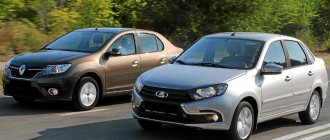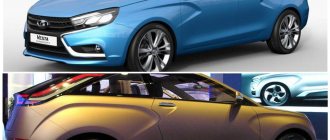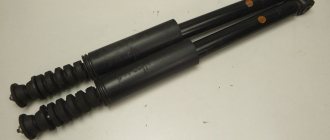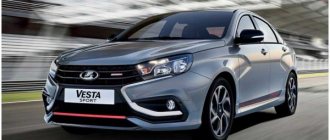In the budget car category, Renault Logan and Lada Vesta are in particular demand. The cars are in the same price segment, have similar dimensions and technical characteristics. But in order to conclude which is better – Renault Logan or Lada Vesta, you will need to compare all the features of the models.
Comparative characteristics of Renault Logan and Lada Vesta cars
Over the past 5 years, Renault Logan has enjoyed the title of leader in the budget class. At the same time, he has to compete with an inexpensive representative of the Russian automobile industry - Lada Vesta.
Considering the low cost of the 2 models, they sell equally well on the Russian market.
But Logan has a much longer history, as it has been on sale for about 10 years and is confidently occupying its niche.
Lada Vesta has been produced since 2015, but this does not prevent it from competing with the French budget car. AvtoVAZ representatives claim that the updated version of the sedan will be as stylish, practical and reliable as possible. High-quality but inexpensive materials were used for its assembly, and the list of on-board equipment is almost the same as that of Logan.
The car from the Renault concern has received great demand due to its good adaptation to harsh operating conditions. She is not afraid of severe frosts, moderate off-road conditions and other unfavorable factors. In addition, the cost of servicing a foreign car is relatively low, which is an additional argument in favor of choice.
Let's try to identify the leader
Lada Vesta, as well as Renault Logan, which has been represented on the domestic automobile market for about 10 years, have many advantages over many other modern cars, which puts them an order of magnitude higher in our market segment. The Lada model immediately became popular, and its sales are incredible, but the Renault model is also consistently the best-selling foreign car in our country. Opinions differ here, which is better? It's worth continuing the comparison.
So, Lada Vesta is larger in overall dimensions than its competitor, and has 100mm more in all parameters. This makes the car belong to class B+, but Renault Logan does not have a plus sign. This allowed Vesta to get a large luggage compartment and a spacious interior. And the car itself, which is equipped with sports overhangs, despite the fact that its dimensions are impressive, looks respectable.
If we compare cars from the point of view of the interior and its design, then the representative of France becomes the undisputed leader. Although the first generation car is more suitable as a family car, which is reflected in the interior design.
Officially, Renault Logan engineers position it as a budget model, so inexpensive materials were used in the finishing. What speaks most about a car is its comfort and driving dynamics. This is evidenced by the power of the power plants of the Lada Vesta and its competitor. Lada presented its car with a series of power plants, of which there are 4 types, with a capacity of 87 l/s, 102 l/s, 114 l/s and 128 l/s. The Logan sedan is equipped with only 2 units, with a capacity of 82 l/s and 102 l/s. Because of this, the comparison is in favor of the Russian model.
If we talk about objectivity, then West should have been compared with the latest version of Logan. The power units remained unchanged, but a nice, modern, new design appeared. More expensive materials were used in the decoration. And most importantly, for the powerful 102 l/hp engine, a variator was introduced.
If you pay attention to the exterior of the Lada Vesta and Renault Logan, then it is indeed extremely difficult to decide which is better and which to choose for yourself. Both models are clear examples of the latest European design trends, and in their configurations they have the latest technologies and options, and this can now be offered to customers
The Frenchman is still let down by the materials used for finishing. Despite the rather beautiful plastic, it is very hard and not very pleasant to the touch.
If we compare the dimensions, the Renault Logan has a small but advantage over the LADA Vesta model. The domestic model, as before, is larger in size relative to Logan. This sedan from France does not boast a spacious interior and a spacious luggage compartment, but this makes the maneuverability of the car much better, and it is also much easier to park in such a car, which has been very important lately.
The driving characteristics of the Renault sedan have become better than those of the 1st generation, however, the model does not lag behind the Lada, and offers buyers modern engines and transmissions. In total, only 2 power plants are offered for foreign cars, while Russian cars have 5 of them. In addition, Russian engines are more dynamic and responsive, which makes domestic developments the leaders.
Prestige and body
After another restyling, the French car began to look more stylish, but at the same time retained its status as a reliable vehicle for everyday use. The key advantages of this car are safety and durability, but not excessive luxury.
Its main rival, the Lada Vesta, which is also available as a sedan, is characterized by a simple suspension that is resistant to driving on bumpy roads, a minimal set of comfort options and cheap maintenance.
Appearance (design)
In terms of body and cabin design, the domestic new product is somehow superior to its competitor. It exhibits pronounced features of the high-tech style. Logan looks more conservative and laconic, but also deserves attention.
Interior
The second generation of Logan demonstrates a big breakthrough in interior design. Now the car is not only functional and comfortable, but also stylish. A new instrument panel with chrome dial elements, a redesigned console and steering column make the car modern and attractive.
The amount of space for rear passengers is small, but the second sofa can accommodate 3 adults. The rear row does not fold flat, but in a 60/40 configuration, which allows you to expand the trunk volume. Also, the new Logan uses improved finishing materials, and the ergonomics of the seats are at the highest level.
The interior decoration of the Lada Vesta looks more stylish. The dashboard, console and trim combine affordable luxury and practicality. In addition, the cabin provides more space for passengers to board, since the car is located at the junction of segments B and C.
In terms of ergonomics, there are no complaints. All controls and important systems are always at hand.
Exterior
If when choosing a Lada Vesta or Renault Logan the main emphasis is on the exterior design, then the domestic sedan is much better than its French competitor. The appearance of the latter follows the economy class style, which is emphasized by miniature optics lights, a gas tank hatch with a cutout for fingers and other cheap details. And the most unpleasant moment is the utilitarian recesses of the door handles.
From the side, the car is almost featureless - the profile has no stampings, chrome inserts or other authentic elements.
But the front of the car looks quite stylish. The radiator grille, air intakes and rectangular optics complement each other.
The rear projection is designed well. This applies to the trunk lid, brake lights and bumper.
Vesta's exterior is dominated by aggression and swiftness. The profile is decorated with stampings and curves of the body panels; in front there is an original radiator grille and “squinted” headlights. And the increased size of the wheel rims only enhances the effect of moderate luxury.
The length of the wipers on the models is identical and is 510 mm in the base.
Above the curb
But it was not for the sake of nameplates on the body and inscriptions in the interior that all these crossover games were started. The key to elevated sedans is their ground clearance numbers and obstacle-clearing ability.
Here, both cars are fine, although their ground clearance is different. “According to the passport,” the lowest point of the Vesta body moved away from the ground by 203 mm, the Renault’s ground clearance is 195 mm. If we talk about the distance under the bumpers, which is more important in the city, then the competitors are almost equal.
But on the Stepway you can park backwards near any curb: in this case there is 370 mm of reserve under the bumper versus 330 mm for the Cross. By the way, the height of Stepway differs quite significantly from just Logan - according to the manufacturer’s data, the difference is as much as 40 mm! The clearance of the Cross version is only 25 mm greater than that of the Vesta sedan.
The ground clearance of both cars is impressive, so on snowy roads they feel better than their “down-to-earth” competitors. Front-wheel drive is not a hindrance - this couple slips through snow debris at speed, without even touching the bottom. The main thing is not to brake and remember how easily a front-wheel drive car “buries” in the snow.
Both test cars have Velcro, but for frequent trips on country roads, studded tires are more suitable - it will be easier to get out on them if the ground clearance alone is still not enough.
Technical features
The models under consideration belong to the same body segment and have similar prices and technical characteristics. But they also have global differences.
Platforms
Lada Vesta is considered better than Logan due to its overall dimensions. She belongs to the B plus platform and is several centimeters larger than her opponent. Logan also belongs to class B, but its dimensions are smaller.
Engines and resource
And although only 1 power unit is offered with Vesta, and 2 units with Renault Logan, the first option is much more powerful. The French sedan is available with a primitive 8-valve 1.6 liter engine. The engine uses multi-point distributed injection and has a power reserve of 82 hp. Torque at 2,800 rpm reaches 134 Nm.
The dynamic performance of the model is quite good:
- Acceleration to 100 km/h takes 11.9 seconds.
- The speed limit is limited to 172 km/h.
- Fuel consumption per 100 km in the combined cycle is 7.2 liters.
More advanced trim levels include a 102-horsepower 16-valve unit with a torque of 145 Nm. Its dynamics look better:
- acceleration to 100 km/h takes 10.5 seconds;
- permissible speed reaches 180 km/h;
- Gasoline consumption is 7.1 liters per 100 km in combined mode.
Vesta can only be purchased with a single 1.6-liter Russian-made engine. The unit has 102 l. With. power and torque of 148 Nm. In terms of dynamics, this engine is only 0.1 seconds faster than the base Logan engine.
And it is inferior to the more productive version of the competitor by 1.3 seconds. Fuel consumption is 6.9 l/100 km combined cycle.
Both units are characterized by reliability and durability. Their service life reaches several hundred thousand kilometers, and the cost of maintenance remains low. The main thing is to know what kind of gasoline to pour into the fuel tank.
Gearboxes
The situation with the transmissions of the 2 cars is identical. Both Logan and Vesta are equipped with a 5-speed manual transmission and a 5-speed robotic system. The manual transmission of a domestic car is better - it responds faster to the driver’s actions, and the lever stroke does not produce squeaks, play or problems.
The robotic complex is equally good for 2 machines. He solves his problems without any complaints.
Chassis
The updated Logan is adapted for use on Russian roads. The rear shock absorbers were strengthened, so the car received a smoother and softer ride.
The advantage in ground clearance allows Vesta to maneuver on bumpy roads where there are many bumps and potholes.
Pendants
The structure of the opponents' chassis is almost identical. The suspension consists of MacPherson struts and a torsion beam. Lada Vesta engineers have prioritized improving off-road performance and adapting the chassis to moderate off-road conditions. Therefore, the suspension design turned out to be reliable and energy-intensive.
Increased ground clearance allows you to overcome various obstacles without losing control.
Logan is less versatile. It has some shortcomings in the precision of control and the reaction of the wheels to the movement of the steering column. However, the indestructible suspension makes up for these shortcomings.
Chassis
There is serious rivalry here. The design of competitors is the same and simple - MacPherson struts and torsion beam. The creators of the LADA Vesta oriented the sedan for driving on Russian roads. As a result, the chassis turned out to be energy-intensive and durable, and the high ground clearance helps. At the same time, the car was endowed with enviable handling, which has already been noted more than once.
Logan is not so versatile. It frankly lacks precision in taxiing and feedback from the steering wheel to the wheels. But the fantastic “indestructibility” of the chassis, so valued by Renault fans, has not gone away - you can drive over speed bumps without slowing down at all!
Options and cost
Cars are offered in several trim levels, which differ in price, available body colors and other parameters. Lada Vesta is available in the following delivery packages:
| Version | Price in rubles |
| Classic | 584 000 |
| Comfort | 637 000 |
| Luxe | 700 900 |
| Exclusive | 814 400 |
In the basic version, the car has a hill assist system, ABS, EBD, ESC and other useful assistants. By default, the steering wheel is adjustable for reach and tilt, as well as electric power steering.
The French sedan is available in the following versions:
| Equipment | Price in rubles |
| Access | 544 000 |
| Life | 607 990 |
| Drive | 682 990 |
| Style | 772 990 |
The list of on-board equipment in Logan's budget variants is minimalistic. To get comfort options such as air conditioning, adaptive cruise control, heated seats and steering wheel, you will need to choose a more premium package.











